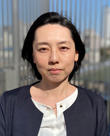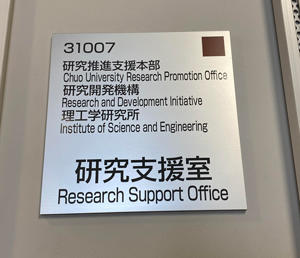2022.01.25
Physics × Scientific Communicator = URA?

- Yoshiko Baba
- University Research Administrator (URA), Chuo University Research Promotion Office
Areas of Specialization: Research Support, Physics, Scientific Communication
What is URA?
Have you ever heard of "URA?"
URA is an abbreviation for "University Research Administrator." A URA is a specialist with specialized knowledge and skills who is involved in research promotion aimed at invigorating the research activities of researchers at universities and other institutions. Since January 2021, I have served as a URA at the Chuo University Research Promotion Office. My duties are to support research, mainly in the form of research publicity.
I would like to begin by giving a brief introduction of a URA. The reason why URAs are active today is that researchers are finding it increasingly difficult to secure research time. The needs which society expects universities to fulfill are changing on a daily basis. The international competition involved in research is intensifying. Furthermore, researchers are faced with an excessive burden of work that is incidental to their research activities; for example, filing applications in order to secure competitive funds for financing their research and conducting overall management of research. Under these circumstances, the Science and Technology Policy Bureau at the Ministry of Education, Culture, Sports, Science and Technology (MEXT) has launched a project entitled "Development of Systems to Cultivate and Secure University Research Administrators (URA)."[i] This project aims to create an environment where researchers can concentrate on their research, improve the quality of academic research, and invigorate research activities. Based on this project, the URA System started from 2011. Of course, positions to support research that are similar to the role of a URA existed prior to the system. Even today, there are many people who are engaged in research support work under titles other than URA.
Where are the URAs at Chuo University?

Research Support Office on the Korakuen Campus. On the Korakuen Campus, URAs are stationed in the Research Support Office on the 10th floor of Building No. 3.
URAs are professional human resources who are assigned to universities. However, the way in which URAs are deployed and the missions which they are given differ depending on the organization. At Chuo University, five URAs conduct research support activities under the supervision of the General Manager of the Research Promotion Office (as of March 4, 2021). URAs at Chuo University (hereinafter, "Chuo URAs") work as a team while possessing a high level of expertise in research, education, international fields, business, and scientific communication.[ii] Chuo University Research Promotion Office was established in 2015 with the aim of invigorating research activities throughout Chuo University and promoting agreements/collaborations with external organizations such as industry and government offices. The Research Promotion Office strives to return research to society by providing prompt and flexible support from research proposals to project management/operation, intellectual property management, and technology transfer. During these efforts, each Chuo URAs fully utilize their specialized knowledge and skills that he/she has cultivated, plans and proposes new perspectives and initiatives which did not previously exist at Chuo University, and provides powerful support for advancing projects that are already in progress. Of course, URAs alone are not capable of providing all the necessary support for research. Collaboration with researchers and administrative staff is indispensable. Chuo URAs must possess a certain level of understanding for university-related research and development, and must perform their duties while communicating with researchers and administrative staff. Therefore, Chuo URAs have a record of experience and achievements in relation to research activities. The workplace of URAs is located in the Research Support Office (Korakuen Campus) and Research Grant Section (Tama Campus). These locations enable URAs to collaborate with administrative staff on a daily basis.
The beginning of my career as a URA
Personally, I first heard the term "URA" six years ago when I applied for the position of URA at my previous job. (I was previously a URA at a national university in Japan.[iii])
I would now like to briefly introduce how I became involved in research support as a URA. My area of expertise is physics. I had been engaged in research on nuclear physics using accelerators and been conducting research at a facility within the Institute of Physical and Chemical Research (RIKEN).[iv] When I was a graduate student, I witnessed how researchers with whom I worked had difficulty securing research time. This was due to the yearly increase in the attendance of meetings and submission of paperwork. I began to wonder if there was any opportunity for human resources with expert skills to work at research institutions. However, the majority of people around me were active in academics, and there were not so many people around me with whom I could consult regarding a career path outside of academics. Besides, without many friends to consult, I was unsure of where I could obtain useful information.
During the period in which I was having such vague thoughts, the Great East Japan Earthquake occurred in 2011. This caused me to consider the form of relationships between scientific technology and society. As my next step, I decided to serve as a bridge between science and society. After obtaining my degree, I worked as a science communicator[v] at the National Museum of Emerging Science and Innovation (Miraikan). Through my discussions with museum visitors, I felt the expectations toward scientific technology from society. I spent time considering how scientific technology should be by engaging in various activities such as writing blog articles on research topics and developing experiment workshops in cooperation with researchers. Through these activities, I reconfirmed the need for measures to achieve more efficient two-way communication between researchers and society, including improvement to the methods used when researchers communicate information to society. I began to feel the desire to embark on a new stage of my career which involved providing close support to researchers.
Afterwards, I took my first step forward as a URA.
What are the skills of URA?
A URA has to handle a wide range of tasks that include procuring and managing research funds, managing and utilizing intellectual property, and planning and managing research programs. Therefore, there are many skills which are required. The functions, administrative skills, and capabilities required of a URA are summarized in the "Skill Standards for University Research Administrators (URA)."[vi] In many cases, URAs acquire their knowledge and skills while actually working to support research. Even so, I still believe that it is possible to acquire the necessary skills before embarking on a career as a URA. For example, when I was involved in accelerator experiments, we normally formed a group of about 10 to 30 people. We would then form sub-groups for each required theme of the experiment, with the experiment manager providing overall supervision. Work in the sub-groups was then executed efficiently under the guidance of the sub-group leaders. This kind of experience is similar to experience in research management. Through the aforementioned experience, I think I was able to obtain skills which are related to URAs--for example, managing schedules, building a group collaboration system, devising information sharing, ensuring risk management in the event of trouble, and facilitating flexible response. Moreover, as a science communicator, I had the opportunity to engage in dialogue with people from various positions in society, and to experience the diversity of the science communicators who were my colleagues. (Some of those science communicators had experience in overseas research/activities or corporate activities, and they all came from diverse research backgrounds.) This enabled me to acquire a broad perspective which is useful in my current work as a URA.
Conclusion
The number of universities where URAs are stationed is increasing. In recent years, URAs are becoming even more important due to heightened needs for strengthening research capabilities (including collaboration with industry) and for greater diversity in the procurement of funds related to university management. In view of the importance of roles fulfilled by URAs, and in recognition of the need to guarantee the quality of URAs, consideration is being given to a system for certifying the practical ability of URAs.[vii][viii] Indeed, at Chuo University, URAs fulfill the role of a "lubricant" for smooth execution of research. Personally, I will continue to take on new challenges aimed at developing an environment that enables researchers to concentrate on their research, and at achieving qualitative enhancement and invigoration of academic research.
[i] "Development of Systems to Cultivate and Secure University Research Administrators (URA)," the Science and Technology Policy Bureau; the Ministry of Education, Culture, Sports, Science and Technology https://www.mext.go.jp/a_menu/jinzai/ura/
[ii] URA Team, Chuo University Research Promotion Office https://www.chuo-u.ac.jp/research/industry_ag/clip/ura/
[iii] Office of Research Strategy and Development, the Graduate School of Science, the University of Tokyo https://www.s.u-tokyo.ac.jp/en/
[iv] The Center for Nuclear Study, the Graduate School of Science, the University of Tokyo https://www.cns.s.u-tokyo.ac.jp/en/
RIKEN Nishina Center for Accelerator-Based Science https://www.nishina.riken.jp/
[v] Science communicator, the National Museum of Emerging Science and Innovation (Miraikan) https://www.miraikan.jst.go.jp/aboutus/communicators/
[vi] "Report on Results of Development of Systems to Cultivate and Secure University Research Administrators (URA) (Creation of Skill Standards)," the Science and Technology Policy Bureau; the Ministry of Education, Culture, Sports, Science and Technology https://www.mext.go.jp/a_menu/jinzai/ura/detail/1349663.htm
[vii] "Report on Results of Survey Research for the Construction of Quality Assurance Systems for University Research Administrators," the Ministry of Education, Culture, Sports, Science and Technology https://www.mext.go.jp/content/20200430-mxt_sanchi01-000005991_1.pdf
[viii] "Survey and Verification for Implementation of Certification System for University Research Administrators," Kanazawa University http://ura-cert.w3.kanazawa-u.ac.jp/
Yoshiko Baba
University Research Administrator (URA), Chuo University Research Promotion Office
Areas of Specialization: Research Support, Physics, Scientific Communication
Yoshiko Baba was born in Tokyo.
In 2004, she graduated from the Faculty of Science, Saitama University.
In 2006, she completed the Master’s Program in the Graduate School of Science, the University of Tokyo.
In 2010, she completed the Doctoral Program in the Graduate School of Science, the University of Tokyo with a PhD in science.
From 2013 to 2015, she served as a science communicator at the National Museum of Emerging Science and Innovation (Miraikan).
From 2015 to 2020, she served as a URA in the Graduate School of Science, the University of Tokyo.
She has held her current position since January 2021.
